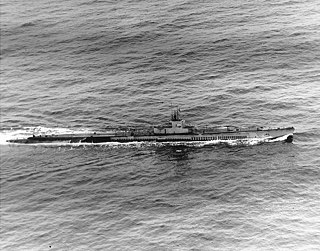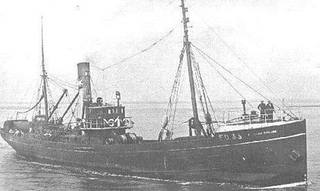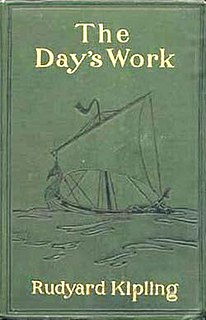German submarine U-27 was a Type VIIA U-boat of Nazi Germany's Kriegsmarine built for service in World War II. Her keel was laid down in November 1935 in Bremen. She was commissioned in August 1936 with Korvettenkapitän Hans Ibbeken in command. Ibbeken was relieved on 4 October 1937, by Johannes Franz, who commanded the boat until 6 June 1939 when Hans-Georg von Friedeburg assumed command for barely one month. He was relieved on 8 July again by Johannes Franz, who commanded the boat until her loss on 20 September 1939.

USS Tautog (SS-199), a Tambor-class submarine, was the first ship of the United States Navy to be named for the tautog, a small edible sport fish, which is also called a blackfish.

USS Bowfin (SS/AGSS-287), a Balao-class submarine, was a boat of the United States Navy named for the bowfin fish. Since 1981, she has been open to public tours at the USS Bowfin Submarine Museum and Park in Pearl Harbor, Hawaii, next to the USS Arizona Memorial Visitor Center.
A ghost ship, also known as a phantom ship, is a vessel with no living crew aboard; it may be a ghostly vessel in folklore or fiction, such as the Flying Dutchman, or a real derelict found adrift with its crew missing or dead, like the Mary Celeste. The term is sometimes used for ships that have been decommissioned but not yet scrapped, as well as drifting boats that have been found after breaking loose of their ropes and becoming carried away by the wind or the waves.

USS Threadfin (SS-410), a Balao-class submarine, was the only vessel of the United States Navy to be named for the threadfin.
"The Ballad of the "Clampherdown"" is a satirical poem written by Rudyard Kipling in 1892.
Pinguin was a German auxiliary cruiser (Hilfskreuzer) which served as a commerce raider in World War II. Pinguin was known to the Kriegsmarine as Schiff 33, and designated HSK 5. The most successful commerce raider of the war, she was known to the British Royal Navy as Raider F.
USS Fox was a captured Confederate schooner acquired by the Union Navy from the prize court during the American Civil War.
SS Lesbian was a cargo ship built for the Ellerman Lines in 1915. On 5 January 1917 she was shelled and sunk by German U-boat U-35, the most successful U-boat participating in World War I, without loss of life.
HMS Lark was a 16-gun ship sloop of the Cormorant class, launched in 1794 at Northfleet. She served primarily in the Caribbean, where she took a number of prizes, some after quite intensive action. Lark foundered off San Domingo in August 1809, with the loss of her captain and almost all her crew.

The SS Carolina was a 380-foot-long (120 m) passenger liner; it was one of six vessels sunk on a single day during World War I by the German submarine U-151 on "Black Sunday". The wreck was rediscovered in 1995 by wreck divers John Chatterton and John Yurga.

The Rudyard Kipling was a British steam trawler launched in 1920 that undertook fishing operations off the coasts of Great Britain and Ireland for almost 20 years. On 16 September 1939, shortly after the outbreak of World War II, the trawler was captured 40 miles west of Clare Island by the German submarine U-27. After removing food, equipment, and the crew from the ship, the Germans sunk her with the use of scuttling charges. Several hours later the crew of the Rudyard Kipling were cast adrift 5 nautical miles (9.3 km) off the coast of Ireland. They eventually landed their lifeboats at Killybegs.

Amaranth was a four-masted barquentine built by Matthew Turner of Benicia, California in 1901. Amaranth sailed in the China trade between Puget Sound and Shanghai. She was wrecked on a guano island in the South Pacific in 1913 while carrying a load of coal.

Cymric was a British and Irish schooner, built in 1893. She joined the South American trade in the fleet of Arklow, Ireland, in 1906. She served as a British Q-ship during the First World War; she failed to sink any German U-boats, but did sink a British submarine in error.

The Mary B Mitchell was a British and later an Irish schooner, affectionately known as Mary B.. She was a pleasure craft, a war hero, a working schooner, a film star and a transporter of essential cargoes in dangerous waters.

Colonist was a general cargo and passenger schooner built in 1861 at Dumbarton Scotland by Denny & Rankine. It spent nearly 30 years plying the Western Pacific-based out of Sydney. It wrecked and later re-floated on the remote Elizabeth Reef 550 km from New South Wales, as well as being involved in the gold rushes. Its master murdered was before it was finally involved in a collision in Sydney Harbour, in which it was sunk.
"The Ship that Found Herself" is a short story by Rudyard Kipling, first published in The Idler in 1895. It was collected with other Kipling stories in The Day's Work (1898).

"Bread upon the Waters" is a short story by Rudyard Kipling, which first appeared in the London Graphic in December 1895. It was later published in The Day's Work (1898). The title derives from Ecclesiastes 11:1 - "Cast thy bread upon the waters: for thou shalt find it after many days". It was originally illustrated by Sir Frank Brangwyn.
















